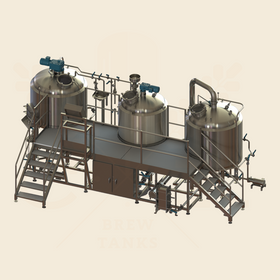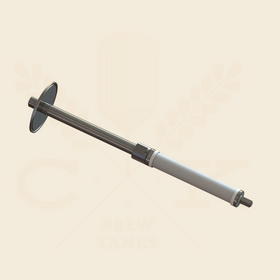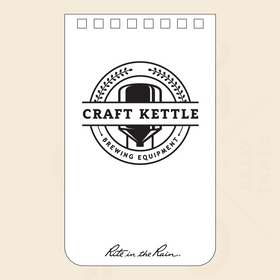
Lautering
Whether you’ve “doughed-in”, “mashed-in”, “striked-in (or struck-in?)” you’ve mixed malt with hot water. From last week’s post, we know that this mashing process is absolutely essential in the production of wort. This week we’ll throw even more brewing terminology your way, because, well, it never ends in this industry.
Many of the terms we’ve discussed and will discuss have been used for centuries to describe specific processes within brewing. Many of them stem from other languages. Brewers benefit themselves when they know or are capable of recognizing which terms mean what. More importantly though, brewers should know the processes and best practices first…the terminology will develop sooner or later.
Following the mash rest, brewers know the sugary wort needs to eventually be separated from the wetted grain; this process is known as the lauter (I told you the terminology wouldn’t stop). Just as so many other phases within the wort production umbrella involve “sub steps” (or steps within the main step), this one is no different. However, our central goal remains the same; separate the wort from the mash.
Specific mash rest times vary by recipe, mashing technique, and brewery. One brewery may routinely conduct 30 minute mashes, while another may have a 1.5 hour mash for this recipe, or an hour mash for that recipe. Although the term “rest” is used (referring to the temperature), brewers typically aim to manually stir (using “elbow grease” and a paddle) or automatically stir (using a motor equipped with paddles) during the mash period. Stirring allows for increased contact between the malt’s starch content and hot water. This increased contact often translates to higher extract content or a higher Brew House Efficiency percentage. A higher BHE means a more efficient use of malt, corresponding with higher cost savings.
Although stirring during most of mash rest is desirable, toward the end it generally is not. Concluding stirring 10-20 minutes before the end of the mash helps start the formation of the “grain bed”. Before the wort can be sent in to the next vessel (the boil kettle), it is typically recirculated through this grain bed. This process is known as vorlaufing. At this step, the brewer is essentially using grain present in the mash tun to act as a filter for the wort.
There are many factors at play regarding this recirculating flow, all of which can be assessed in Darcy’s Law; an equation describing the flow of fluid through a porous medium. The fluid being wort, and the porous medium being our grain filter bed. Generally speaking, time and temperature of the mash, grains used, and width and depth of the grain bed, all directly influence this flowrate. Experienced brewers know how to recognize potentially problematic grain bills and how to troubleshoot batches where the flow stops, or becomes “stuck”, unsurprisingly referred to as a “stuck mash”.
The vorlauf serves to clarify the wort and further develop the grain bed. Wort moves from the mash tun’s false bottom (a screened bottom that allows wort to pass through while retaining most of the grain) to the mash tun’s true bottom. The true bottom typically has multiple, evenly spaced outlets that all feed in to one central bottom pipe. This pipe then typically flows into a vessel known as the grant tank. The grant is simply a buffer vessel that allows the brewer to visually see lauter flow rate and wort clarity. Conveniently, wort samples can also be taken from the grant tank. Some brew houses may or may not be equipped with a grant.


Photo: A half full grant tank acting as a buffer vessel between the mash tun and boil kettle during a lautering run
While gravity can be used to get the wort from the mash tun to the grant, a centrifugal pump must be used to get it back to the top of the mash bed. This pump, typically called the “grant pump”, delivers wort through an external vorlauf pipe to the top of the mash tun. The vorlauf outlet this pump feeds to is typically centered right above the mash bed, and delivers wort to a dispersion plate that evenly, and hopefully, gently, adds it back to the mash tun. The word gently is stressed here as many brewing scientists regard this “hot side aeration” as having negative impacts on the end product’s flavor stability. As a general rule of thumb, brewers try to minimize splashing, vigorous stirring, and fast pump speeds at this point in the process. Some brewers might even go as far as purging brewing vessels with CO2 before filling. Remember the mash stirring we talked about earlier? Well, this too is a chance for oxygen ingress.
Much like mash rest time, vorlauf time will vary by brewery and recipe. With the boom of Hazy IPA’s, vorlauf cycles may be no longer than 5 minutes, or ruled out altogether. Likewise, “brilliantly clear” styles may see upwards of 30 minute vorlauf cycles. Following desired clarity or a set time, the brewer is ready to switch from the sub-step of vorlaufing to the main step; lautering.
Wort flow is redirected from the vorlauf loop to the boil kettle. This redirection may be as simple as switching a couple of valves. The grant tank pump now sends the flow from the bottom of the mash tun to the bottom of the boil kettle, gradually filling it up. These first trickles of wort entering the boil kettle are known as “first runnings”. A first runnings sample may be taken, and is often a good first indicator of BHE. The entire lautering phase of moving wort to the boil kettle is referred to as the “run-off”.
Eventually, the grain bed will become exposed after much of the wort has been transferred to the boil kettle. Hot sparge water is then added on top of the grain bed to avoid air exposure, as well as to rinse the many sugar molecules left behind. The hot liquor tank supplies the sparge water to the mashtun, typically through the same piping the strike water was added before. Using this same piping allows for use of the inline flow meter (again), only this time to record and monitor sparge water volume and flowrate.
In addition to volume, sparge water temperature needs to be taken into account. Sparge water that is too hot (typically above 175°F) can potentially extract harsh polyphenols from the barley husk, possibly causing off-flavors and a hazier appearance in the end product.
At this point the brewer has many tasks on his or her plate: monitor lauter flow, check boil kettle volume, ensure sparge water is completely covering the grain bed, check sparge water volume and temperature, pre-heat the wort in the kettle, take samples, etc. Juggling these tasks diligently is key, as minute changes to lauter flow have the potential to drastically affect BHE.
As the kettle slowly fills, the brewer makes note of the pre-boil volume, which is typically measured with a fancy, high tech (sarcasm) wooden stick that gets lowered into the kettle. It is ideal for this wort to have a near boiling temperature toward the end of the run-off. By having the wort this hot, the brewer wastes no time when starting the next phase; boiling.
Commonly a “last runnings” sample is taken on the final wort entering the boil kettle. The gravity of this sample should be monitored and recorded. Last running gravities that are less than 2.5 °P potentially have higher percentages of the harsh tannins described earlier. This is because of the decreased sugar content in the mash, allowing the hot sparge water better access to husk polyphenols, potentially creating this off-flavor. Lighter styles are more susceptible to these tannic off-flavors, as darker malts have the potential to better cover them up.
Quite a few steps to remember, huh? And you thought we were just separating solids from liquids…
All jokes aside, this liquid/solid separation does remain the main goal. The subsequent “sub-steps” in the lautering process that we’ve discussed are simply efforts aimed to create a high quality wort. At the end of the day, maintaining quality is key, and ever brewery should strive to do so.
Now, you’ve got a kettle full of wort and a whole hour of down time, right? Wrong. Stretch your back out, or find an able-bodied intern… it’s time to empty the spent grain out of the mash tun.
Happy brewing.




